
NGC 4725 is an intermediate barred spiral galaxy with a prominent ring structure, located in the northern constellation of Coma Berenices near the north galactic pole. It was discovered by German-born British astronomer William Herschel on April 6, 1785. The galaxy lies at a distance of approximately 40 megalight-years from the Milky Way. NGC 4725 is the brightest member of the Coma I Group of the Coma-Sculptor Cloud, although it is relatively isolated from the other members of this group. This galaxy is strongly disturbed and is interacting with neighboring spiral galaxy NGC 4747, with its spiral arms showing indications of warping. The pair have an angular separation of 24′, which corresponds to a projected linear separation of 370 kly. A tidal plume extends from NGC 4747 toward NGC 4725.

NGC 7793 is a flocculent spiral galaxy in the southern constellation of Sculptor. It was discovered in 1826 by Scottish astronomer James Dunlop. The galaxy is located at a distance of 12.2 million light years and is receding with a heliocentric radial velocity of 227 km/s. NGC 7793 is one of the five brightest galaxies within the Sculptor Group.
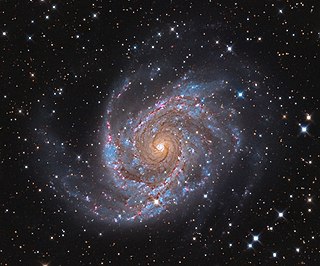
NGC 2997 is a face-on unbarred spiral galaxy about 40 million light-years away in the faint southern constellation of Antlia. It was discovered March 4, 1793 by German-born astronomer William Herschel. J. L. E. Dreyer described it as, "a remarkable object, very faint, very large, very gradually then very suddenly bright middle and 4 arcsec nucleus. This is the brightest galaxy of the NGC 2997 group of galaxies, and was featured on the cover of the first edition of Galactic Dynamics by James Binney and Scott Tremaine.

NGC 1566, sometimes known as the Spanish Dancer, is an intermediate spiral galaxy in the constellation Dorado, positioned about 3.5° to the south of the star Gamma Doradus. It was discovered on May 28, 1826 by Scottish astronomer James Dunlop. At 10th magnitude, it requires a telescope to view. The distance to this galaxy remains elusive, with measurements ranging from 6 Mpc up to 21 Mpc.

NGC 4639 is a barred spiral galaxy located in the equatorial constellation of Virgo. It was discovered by German-born astronomer William Herschel on April 12, 1784. John L. E. Dreyer described it as "pretty bright, small, extended, mottled but not resolved, 12th magnitude star 1 arcmin to southeast". This is a relatively nearby galaxy, lying approximately 72 million light-years away from the Milky Way. It is a companion to NGC 4654, and the two appear to have interacted roughly 500 million years ago. NGC 4639 is a member of the Virgo Cluster.

NGC 5371 is a face-on spiral galaxy in the northern constellation Canes Venatici. It was discovered on January 14, 1788 by German-British astronomer William Herschel. The nearby NGC 5390 appears to be a duplicate entry for NGC 5371, since there is nothing at the former's position. NGC 5371 has an apparent magnitude of 11.3 and an angular size of 4.4′ × 3.5′. It is located at a distance of 129.5 ± 32.4 million light-years (39.70 ± 9.92 Mpc) from the Milky Way, and is receding with a heliocentric radial velocity of 2,552 km/s. The galaxy appears to be weakly interacting with the nearby, equidistant Hickson 68 group of galaxies, and thus may be a member. Collectively, they are sometimes dubbed the Big Lick galaxy group, after the city of Roanoke, Virginia.

NGC 5962 is a spiral galaxy in the equatorial constellation of Serpens Caput. It was discovered by the Anglo-German astronomer William Herschel on March 21, 1784. The NGC 5962 galaxy is located at a distance of 120 million light years and is receding with a heliocentric radial velocity of 1,957 km/s. It is the brightest member of the eponymously-named NGC 5962 group, which overlaps with the nearby NGC 5970 group; the two groups may be gravitationally bound.
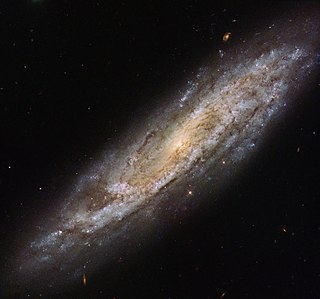
NGC 2770 is a spiral galaxy in the northern constellation of Lynx, near the northern constellation border with Cancer. It was discovered by German-born astronomer William Herschel on December 7, 1785. J. L. E. Dreyer described it as, "faint, large, much extended 150°, mottled but not resolved, 2 stars to north". NGC 2770 was the target for the first binocular image produced by the Large Binocular Telescope.
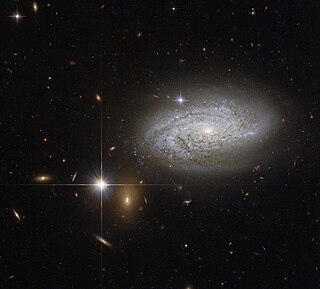
NGC 3021 is a spiral galaxy in the northern constellation of Leo Minor. It is about 93 million light-years away from Earth, and is receding with a heliocentric radial velocity of 1,537±4 km/s. This galaxy was discovered December 7, 1785 by Anglo-German astronomer William Herschel. The morphological classification of NGC 3021 is SA(rs)bc, which indicates a spiral galaxy with no central bar (SA), an incomplete inner ring structure (rs), and moderate to loosely wound spiral arms (bc).
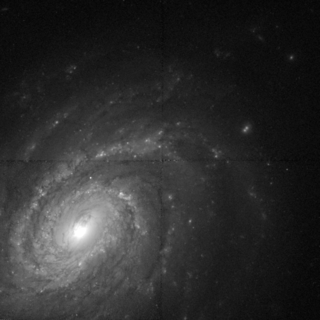
NGC 214 is a spiral galaxy in the northern constellation of Andromeda, located at a distance of 194 megalight-years from the Milky Way. It was discovered on September 10, 1784 by William Herschel. The shape of this galaxy is given by its morphological classification of SABbc, which indicates a weak bar-like structure (SAB) at the core and moderate to loosely-wound spiral arms (bc).

NGC 4424 is a spiral galaxy located in the equatorial constellation of Virgo. It was discovered February 27, 1865 by German astronomer Heinrich Louis d'Arrest. This galaxy is located at a distance of 13.5 million light years and is receding with a heliocentric radial velocity of 442 km/s. It has a morphological class of SB(s)a, which normally indicates a spiral galaxy with a barred structure (SB), no inner ring feature (s), and tightly-wound spiral arms (a). The galactic plane is inclined at an angle of 62° to the line of sight from the Earth. It is a likely member of the Virgo Cluster of galaxies.

NGC 2326 is a barred spiral galaxy in the Lynx constellation. It was discovered by William Herschel on 9 February 1788. Its apparent magnitude is 14.3 and its size is 2.71 arc minutes. It is located near NGC 2326A.

NGC 6951 is a barred spiral galaxy located in the constellation Cepheus. It is located at a distance of about 75 million light-years from Earth, which, given its apparent dimensions, means that NGC 6951 is about 100,000 light-years across. It was discovered by Jérôme Eugène Coggia in 1877 and independently by Lewis Swift in 1878.

NGC 3294 is a spiral galaxy in the constellation Leo Minor. It was discovered by William Herschel on Mar 17, 1787. It is a member of the Leo II Groups, a series of galaxies and galaxy clusters strung out from the right edge of the Virgo Supercluster. The galaxy is located at a distance of 98 million light years and is receding with a heliocentric radial velocity of 1,586 km/s. The morphological class of NGC 3294 is SA(rs)bc, which means this is a spiral galaxy with no central bar (SA), an incomplete inner ring structure (rs), and moderately wound spiral arms (bc).

NGC 820 is a spiral galaxy located in the constellation Aries about 210 million light-years from the Milky Way. It was discovered by British astronomer John Herschel in 1828.

NGC 940 is a lenticular galaxy in the constellation Triangulum. It is estimated to be 222 million light-years from the Milky Way and has a diameter of approximately 80,000 ly. NGC 940 was discovered by Heinrich d'Arrest.
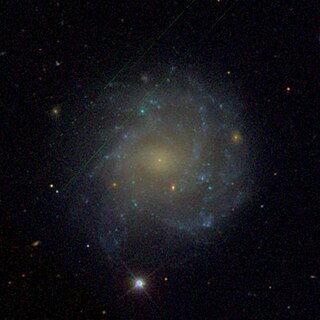
NGC 991 is an intermediate spiral galaxy the constellation Cetus. This galaxy was discovered by astronomer William Herschel in 1785.

NGC 1325 is a flocculent spiral galaxy situated in the constellation of Eridanus. Located about 75 million light years away, it is a member of the Eridanus cluster of galaxies, a cluster of about 200 galaxies. It was discovered by William Herschel on 19 December 1799.

NGC 4589 is an elliptical galaxy located in the Draco constellation. It was discovered by German-British astronomer William Herschel on November 22, 1797. This galaxy lies at a distance of 73.0 million light-years (22.39 Mpc) from the Milky Way, and is receding with a heliocentric radial velocity of 2,002 km/s. It is known by its designations PGC 42139 or UGC 7797.

NGC 3786 is an intermediate spiral galaxy located 107.5 million light-years away in the northern constellation of Ursa Major. It was discovered by English astronomer John Herschel on April 10, 1831. This object appears to form a close pair with its peculiar neighbor to the north, NGC 3788. They show some indications of interaction, such as minor distortion of the disk or tidal features.




















